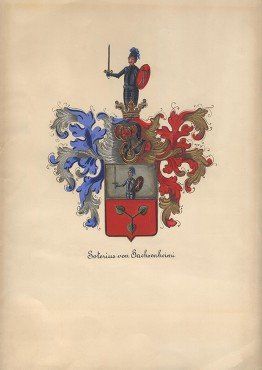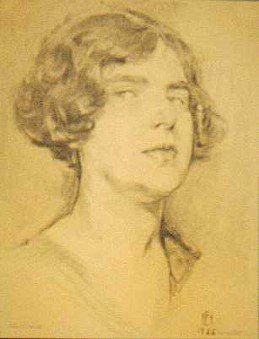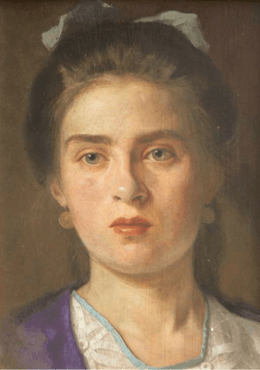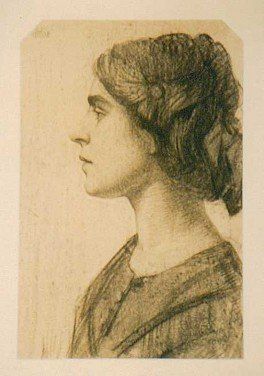Edith Jeanette S.v.S. 1887-1970
Artist with over 200 works to her name.
Edith Jeanette Soterius von Sachsenheim was born on 26 December 1887 in Feldioara (formally Marienburg) in Transylvania Romania to parents of German origin. Edith knew from a young age what she wanted to do: to draw and to paint. Her father; Arthur Soterius von Sachsenheim - Senior Surgeon at the Civil Hospital in Hermannstadt (Sibiu) and her mother, Wilhelmine née Gust from Kronstadt (Brasov) sent their daughter to primary and middle school in Hermannstadt. They recognized from very early on, Edith's artistic talents and arranged in addition to piano lessons (then a standard for well-off families' daughters) but also private lessons in drawing. After the successful completion of a two-year course (1903-04) at Sibiu Art College qualifying her as an art teacher, her father wanted to further nurture his daughter's artistic talent. So he brought her to stay with relatives in England, where she spent one year (1904-05) with her uncle Charles Sockl and his family. Charles Sockl was the son of the very gifted Biedermeier painter couple Theodor Benedikt Sockl and Clara Adelheid Sockl née Soterius von Sachsenheim who lived in Sibiu and Vienna amongst other places during the middle of the last century.
Her uncle's family lived in West Norwood in London, and her days were taken up with English language instruction at St. Julians College followed by piano and art classes - the latter at Knights Hill Technical Institute in Upper Norwood. Of great importance is the fact that she was, for a few months during their so-called 'student days', granted permission by London's National Gallery to copy museum works, a task which she engaged in with great enthusiasm. Above all, she was intrigued by Turner's watercolours which she copied, you will find plenty of evidence of the influence of this inspirational English artist on her own watercolours. In her early works, as well as in works she produced almost half a century later, her colours, applied with loose brush strokes, atmospherically blur in a distinct Turneresque manner the objects’ linear contours in transparent hues. In July 1905, Edith was awarded a 'distinction' grade on a piano exam at the "London College of Music".
After an eventful year in England, in August 1905 her father came and took her back home. In order to foster their daughter's artistic talents further, her father decided in September 1907 that she should continue her studies in Munich for a number of years. She enrolled at the “Royal College of Art and Crafts”, where she developed a major interest in portrait art and also took anatomy classes – a typical, traditional career of an ordinary academy student of whom nothing extraordinary was expected. A year later, in 1908, the most important chapter of her apprenticeship began when she started to visit the studio of Professor Moritz Heymann, a renowned painter and graphic artist. More important than her acquiring a thorough knowledge of the techniques of printmaking was her introduction into the artistic circle surrounding “Studio Heymann”. She got to know the masters many German and foreign students and his artist friends, some of whom had a close affinity to the artistic group "Jugend". Edith’s works dating back to this period, e.g. “Sitzender Halbakt” ("Seated Semi-Nude") or the portrait of her friend Eleanor Garrett-Ward, clearly reflect her ambition to overcome the dated artistic conceptions of the academy. In these, as in all the other works of this creative period, we frequently find the elegant, flowing lines and the decorative extensive colourings of Art Nouveau. Apart from returning home for holidays, Edith spent three years studying in Munich. In 1911 at the age of 23 Edith returned to Sibiu Transylvania. An art gallery in Brasov showed her works, these were also reproduced in Transylvanian monthly journals.
A year later in 1912 she married Dr. med Franz Herfurth, son of the Vicar of Brasov,who had just completed his medical studies in Graz Austria. His skills were needed there, so the couple stayed in Austria for the first world war years where Edith managed to paint some watercolours.
This completes the most interesting phase of her artistic development, an equally fruitful creative period would never return. To Edith; it happened as to most other female artists of her time and for many decades to come: To a large extent, her artistic ambitions were sacrificed on the family altar as she then became the mother of three children; Editha, Günther and Eva. Opportunities to devote herself to her art at least to some extent were to be very limited.
The most important consequence of her frustration came when she radically gave up any form of modernism and confined herself to a strictly objective, highly skilled, realistic representation of her subject. Also In a beautiful self-portrait from 1925, she still appears to be very energetic and purposeful.
This may shed some light on her marriage not lasting as they separated in 1926. Edith married for a second time in 1927 to her childhood friend now Professor Ludwig Herbert a maths lecturer. However he was also not conducive to her artistic work, so Edith continued being a mother and started doing some work as an English teacher. Sadly Ludwig died suddenly of a heart attack in 1936 he was only 51. In 1938 Edith decided to move to south Germany to be near her daughters who’d both moved there, this then brought on a new phase in Edith’s artwork. Up to 1946 she taught art in various schools and painted in her spare time which again she now had plenty of.
More bad news though was to come, in January 1946 her son Günther died of kidney failure aged 30, he had been ill since 1936 after having had a nervous breakdown. This was a very difficult time for Edith as Günther himself had shown promise as an artist, his sketch books are kept by his younger sister Eva. In August 1946 Edith moved to Graz in Austria with here eldest daughter Editha, who now had a son by the name of Heinz Herfurth lived, however, Edith suffered a fall and broke her left wrist which stopped her painting for a while.
But another creative phase followed in 1948 when she produced a series of watercolours in the areas of Graz and Zurich. These works are influenced to some extent by her formerly mentioned early encounter with Turner's art. At the same time these watercolors contain all her inner strength and one can sense in them the frustration of her artistic endeavours. Edith continued to paint in Graz until 1955 but she couldn’t find any work post the war.
Edith had had a turbulent life, with divorce, untimely deaths and financial hardship for many years. Her youngest daughter Eva had moved to England in 1947 and in 1952 had married an English man. Eva had been sending her mother money to keep her fed but it was decided that it would be better if she came to live in London to be looked after by Eva for her remaining years, so in October 1955 Edith moved to London and another phase of art began.
Once settled in London, Edith enjoyed painting the views from the house in Hampstead and doing drawings of her daughter and new son-in-law Ernest Glyn White. She did a fine self-portrait in 1957 and drew her new second grandson Dylan White shortly after he was born in 1958. She continued to paint in the 1960’s mainly of roses but there weren’t to be anymore drawings of her grandson Dylan as he refused to sit still for long enough! Edith’s health gradually detoriated and she died peacefully at the family home in Wimbledon on 4th January 1970 just after her 83rd Birthday. Her grave is in the Gap Road Cemetery Wimbledon and is mentioned in the book on famous London graves written by Darren Beach called London Cemeteries.
Exhibitions
1911 Brasov galleries showed her works, these were also reproduced in Transylvanian monthly journals.
1921 Made roses with the fabric ‘Georgette’ and had them on show at an arts and crafts fair in
Bucharest where she won a silver medal for them.
1952 Instigated by her daughter Eva now living in London. Edith submitted a landscape watercolour to
the Foyles Book Stop International Artists Competition. In this category she won the silver prize.
1957 Now living in London, Edith submitted and had exhibited, a drawing of 'A little girl from Krakow' at
the Royal Society of Portrait Painters. The exhibition travelled all around the country.
1998 The Transylvanian Museum in Gundelsheim Germany staged a retrospective exhibition and
bought fifty of her paintings some of which are on permanent display in the museum.
They also have a lithograph of an ‘Old Italian man’ plus the zinc plate for it.
1999 The Gundelsheim collection was put on show in Munich at the ‘Haus des Deutschen Ostens’
2001 The Military History Museum of Vienna bought three portraits of World War One Officers that had
been drawn at the time of the war in Austria. These are on display there.
In her lifetime Edith created over 200 paintings, drawings and lithograpths. Apart from the paintings in the museums, some others are with friends and relatives in Europe. Her daughter Eva has the remaining paintings and lithographs plus a case of drawings and sketches, she also has all of Edith’s art tools for lithographs plus her pencils and brushes.
Art contemporaries and friends
Arthur Coulin: A friend from Sibiu, did an oil-painting of Edith in 1907 in Sibiu when she was 19 years old. The portrait is in the Gundelsheim Museum.
Ernst Honigberger : A friend from Sibiu also studying in Munich, did a fine pencil drawing of Edith aged 20 in 1908. This is now in the Gundelsheim Museum.
Robert Wellman: A friend from Sibiu, became a family friend and did a portrait of Edith’s father Arthur Soterius von Sachsenheim. This is in the family home in London, England.
Trude Schullerus: A friend from Sibiu also studied in Munich, remained a friend of the family for life.
Paintings bought and exhibited by the Gundelsheim Museum
1. Romanian peasant girl, 1903, charcoal
2. Man with beard, 1903, pen and ink drawing
3. The “Gold Valley” near Sibiu, 1904, watercolour
4. “Franz Geisberger – Shoe Shop”, 1904, watercolour
5. Outskirts in West Norwood, 1905, watercolour
6. Winter in Sibiu, ca. 1906, watercolour
7. On the beach in Grado, 1906, watercolour
8. Portrait Paula Fritsch, 1907, stone engraving
9. Heltauergasse (“Heltau Lane”) in Sibiu, 1907, chalk
10. Heltauergasse (“Heltau Lane”) in Sibiu, 1907, pen and ink drawing
11. Skutari near Constantinople, 1907, pen and ink drawing
12. Skutari near Constantinople, 1907, etching
13. Picture of an old woman, ca. 1907, pencil
14. Young Saxon girl from Michelsberg, 1907, pen and ink drawing
15. Old woman with basket, ca. 1907, charcoal and watercolour
16. Seated semi-nude, 1908, pen and ink drawing
17. Lady with a big hat, 1908, ink and watercolour
18. Lady with a big hat, seated, 1908, ink and watercolour
19. Old man with a pointed cap, 1908, ink and watercolour
20. Portrait Eleanor Garrett-Ward, 1908, brush drawing and watercolour
21. Old man with a moustache, 1908, etching
22. Nude woman with a jar, 1908, etching
23. Nude from behind, 1908, etching
24. “Happy Easter“, 1908, aquatint
25 Spanish female, 1908, etching
26. Student at Studio Moritz Heymann, 1908, pencil
27. Italian, 1908, pencil and charcoal
28. View from Heltau on to Michelsberg, 1908, watercolour
29. Italian with hat, ca. 1908, etching
30. Self portrait, 1909, pastel
31. Young woman with hat, 1909, pencil and chalk
32. Portrait Lisa Tschuckly, ca. 1911, pencil and charcoal
33. The foothills of Negoi, ca. 1911, pen and ink drawing
34. Portrait Mrs Kronberger, 1912, chalk
35. Morning at the Wörthersee, 1916, watercolour
36. Self portrait, 1925, chalk
37. The “Gingerbread House“ (Schwäbisch Hall), 1944, pen and ink drawing and watercolour
38. Timber-framed houses in Schwäbisch Hall, 1944, pen and ink drawing and watercolour
39. Pilgrimage church in Bergatreute, 1945, pen and ink drawing and watercolour
40. Landscape near Bergatreute, 1945, watercolour
41. Farmhouse in Witschwende near Bergatreute, 1946, pen and ink drawing and watercolour
42. Eckartsleitner farm near Admont, 1948, pen and ink drawing and watercolour
43. Landscape by the Schöckl near Graz, 1949, watercolour
44. Farm near Graz, 1949, pen and ink drawing and watercolour
45. The “Red Cliff“ in Styria, 1949, watercolour
46. The “Hohe Buchstein“ (a mountain) near Admont in the evening sun, 1950, watercolour
Paintings donated by her daughter Eva to the Gundelsheim Museum.
Peasant girl with bonnet seated, 1909 watercolour
Romanian peasant woman with jug from Sibiu, 1909 Lithograph
General Major Graf Paul von Wurmbrand from Vienna painted in Portschach 1917, Lithograph
Dr. Franz Herfurth the Vicar of Kronstadt 1921 Lithograph (Edith’s father-in-law)
Hella Durlesser daughter of the Lutheran Pastor of Ploiesti 1936 pencil drawing
Drawings bought by The Military History Museum of Vienna (Heeresgeschichtlichen)
Portrait in pencil of the young officer Sadowski from Sibiu 1907
Portrait lithograph of Lieutenant Max Herzberg from Sibiu 1911
Portrait lithograph of General Major Graf Paul von Wurmbrand from Vienna painted in Portschach 1917
This article was written by MariusTataru at www.siebenbuergisches-museum.de for Edith's exhibition.
This document has been translated by www.janserKraft.com





